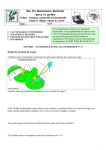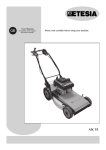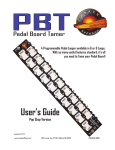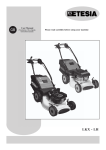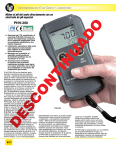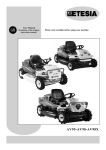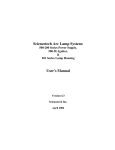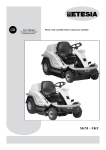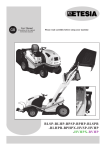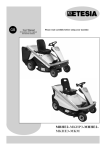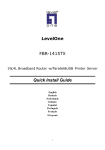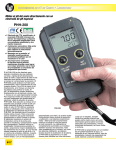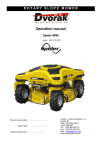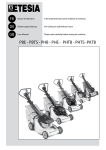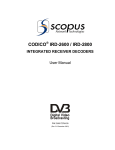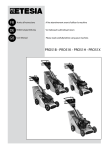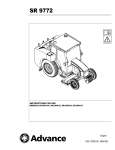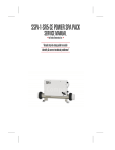Download Etesia Pro 46 mower range Uk operators owners manual to
Transcript
GB User Manual (Translation of the originals instructions manual) Please read carefully before using your machine PBE - PBTS - PHE PHTS - PHTB Key to diagrams Engine pictograms This sign gives advice about your safety. This sign gives recommendations concerning the long life of your mower. Fuel is extremely inflammable and explosive. Stop the engine before filling up. DO NOT SMOKE. Fill up in a well ventilated place away from any source of flames or sparks. The exhaust gases contain carbon monoxide, a lethal, odourless gas. Do not run the engine in a closed space. To avoid serious burns, do not touch the exhaust when it is hot. Description of the safety labels a- WARNING ! b- Before using, please read and follow the safety and maintenance instructions included in the manual. c- Fingers cut risks. d- Stop the engine, disconnect the spark plug before proceeding any services on the mower. e- Risk of projected objects. f- Keep the third persons away from the machine. g- WARNING DANGER ! h- Do not use the lawnmower if the grassbox and/or the shield/ deflector are not in place. a c e g b d f h Operating and Maintenance manual for the Mowers PBE - PBTS - PHE - PHTS - PHTB Summary 1. Your safety and that of others.................................................................................................................................................................... 4 2. Description................................................................................................................................................................................................. 6 3. Pictures..................................................................................................................................................................................................... 11 4. Description of graphical symbols............................................................................................................................................................ 14 5. Technical specifications........................................................................................................................................................................... 15 6. Preparation and getting started................................................................................................................................................................ 16 7. Operation................................................................................................................................................................................................. 17 8. Regular maintenance of your lawnmower............................................................................................................................................... 18 9. Prolonged stoppage - Winter storage - Re-starting up............................................................................................................................. 19 10. Standard repairs - Problems and remedies............................................................................................................................................ 20 11. Regular maintenance summary table..................................................................................................................................................... 21 12. General warranty conditions.................................................................................................................................................................. 22 C ongratulations You have just bought an ETESIA lawnmower. This amazingly strong and reliable lawnmower has been designed to last. In order to increase its lifetime and ensure best operation, please read this instruction booklet very carefully and make sure you follow the safety and maintenance instructions. Store this booklet in a safe place for any later need. This mower is only done to mow lawn. Any use out of lawn is to avoid. ETESIA has a policy of continuously improving the quality of its products, therefore your lawnmower might show slight differences compared with the description in the present booklet. Your ETESIA dealer is in possession of the most recent technical specifications. Do not hesitate to contact him. Before using your mower • Prior to use, check that safety labels are present on the mower as indicated in the manual. Read these labels carefully. If any safety labels are missing, inform your dealer immediately. • The mower is required by law to carry them. • Before using your mower, make sure that you are completely familiar with the controls and operating instructions so that you are able to stop the machine quickly. • Before mowing, always clear the lawn of stones, pieces of wood or metal, wire, bones, plastic, branches and other debris liable to be thrown out by the mower. Low branches liable to cause injury to the user should also be removed. • Before using the mower, always check the condition and adjustment of the blade. • Never wear baggy clothes when mowing. Always wear closed, sturdy non-slip shoes. You should also wear long trousers. 1• Your safety and that of others • Always follow these instructions when using your mower. • Children under the age of 16 years, and people not familiar with the mower must not be allowed to use the machine. • Never let a person who has not read the instruction booklet take charge of the mower. • Never drive your mower too close to embankments or ditches, on soft ground, or where there is a risk of overturning. • Never operate the machine when feeling tired or unwell, or after consuming alcohol or taking medicine. • The user is responsible for ensuring the safety of others within the area where the mower is being used. Whilst mowing, take care to avoid injury to others caused by flying stones and other objects. • Keep a safe distance from people and animals when the engine is running. Do not start the machine if there are any around you. • Never remove warning labels or safety instructions. • The mower has to be always equiped with its safety shield / deflector and safety rubber flap. Never use the mower if the guards are defective. • Never place hands or feet under the cutter housing. • Keep your hands and your legs clear of rotating or moving parts. Always keep clear of the ejection opening. • Before removing the grassbox or change the cutting height stop the engine or the blade rotation. • Avoid obstacles such as mole hills, concrete pedestals, tree stumps and edging, which cannot be cut by the blade and which could damage the cutting mechanism specially the blade. After striking a foreign object or if the machine starts to vibrate abnormally stop the motor, disconnect the spark plug cover and inspect the mower for any damage. Have any repairs made before restarting and using the mower. • Change absolutely the blade after any shock. • Operate the mower only in broad daylight or with good artificial lighting. • Respect the minimum safety distance given by the handlebars. When using the mower on slopes, it is necessary to be particularly careful and to exercise a great deal of caution when changing direction. • Never run, but move forward slowly, taking care with your steps, particularly on a slope. • It should not be used on slopes that are too steep. Work according to the picture 6. • WARNING : NEVER ALLOW THE ENGINE TO RUN IN CONFINED AREAS. EXHAUST GASES CONTAIN CARBON MONOXIDE, WHICH IS ODOURLESS AND CAN KILL. • Always remove the ignition key when leaving the mower unattended, even momentarily. • Stop the engine for any maintenance on the mower. • Turn off the motor before filling with petrol and also whenever the mower is to be left unattended. • The forward control lever is a maintained action device: never lock it closed. • If you have to pull the mower back towards yourself, be very careful. • If the mower has to be lifted or transported, stop the engine and remove the spark plug cap. • If you drive the mower out of the lawn, stop the engine or the blade. • Be sure also to comply with any legal requirements relating to the use of machines with thermal engines. • These precautions are indispensable for your safety. The recommendations given are not exhaustive however. Use your mower judiciously at all times. • By loading and unloading of the machine it is recommanded to use ramps or to ask help for the loading operation. Maintenance and storage • Always maintain the machine and accessories in perfect working condition. • Replace worn or damaged parts for greater safety. • Cleaning or servicing the mower should not be started before having stopped the engine and disconnected the spark plug. • It is highly unadvisable to use a high pressure cleaner which could damage some of the parts. • Always use petrol that you have bought recently. Old petrol leave gum deposits in the carburettor, causes leaks and makes starting the engine difficult. Only buy the amount of fuel you need for on month's use and keep it in a clean jerrican set aside for this purpose. • WARNING: fuel is highly flammable. • NEVER STORE, POUR OR USE PETROL NEAR A NAKED FLAME or near devices such as stoves, water-heaters with pilot lights or any other device liable to produce sparks. • Always fill the fuel tank in the open and do not smoke during this operation. • Add fuel before starting the engine. • Never remove the fuel cap whilst the engine is running or hot. Allow the engine to cool for few minutes before filling. 1• Your safety and that of others (FOLLOWING) • Ensure that the fuel tank and fuel can caps are replaced correctly. • Do not attempt to start the engine when any petrol has been spilt, when you can smell petrol or when other explosive conditions are present. Remove the mower from the spillage area and avoid causing any source of ignition until the petrol vapours have dispersed. • Do not carry the mower with petrol in the tank or with the feed tap open. • Do not modify the regulator springs, rods or other parts to increase the engine speed. Operate the engine at the recommended speed. • Do not check the spark by removing the spark plug. Use an approved checking system. • Do not pull the starter with the spark plug is removed. If the engine is flooded, turn the fuel control to the Max. position and start the motor till it starts up. • Do not knock the engine wheel with a hammer or hard object. Otherwise, the wheel may break during operation. Have all major servicing operations performed by an authorised ETESIA repairer who has the appropriate tools. • Do not use the engine without the silencer. Check the silencer regularly and have it replaced if its is damaged or leaking. • Do not touch the exhaust pipe, cylinder or fins when hot. Otherwise, you may get burnt. • Do not use the mower in wooded areas, brush or on fallow or grassy ground if the exhaust pipe is not fitted with a spark arrester (the owner or user is responsible for ensuring that the spark arrester is in good condition). • Do not start the engine when the air filter or air filter cover is removed. • To prevent the engine from starting accidentally, remove the spark plug cap during servicing operations. • Clean the cylinder fins and regulator mechanism of any dirt, grass residues and other materials which could alter the engine speed. • Pull the starter cord slowly till you feel resistance. Then pull it energetically to prevent recoiling and hurting your hand or arm. Check the fuel piping and connections for cracks and leaks and have them changed if necessary. • The spare blades must only be fitted on machines for which they are designed, in accordance with the instructions. • Use only original ETESIA spare parts. The use of inferior quality parts can damage the engine. Responsibility • In the event of any use not in accordance with the relevant instruction booklet, ETESIA can accept no liability. • You must not make any modifications to the mower without the prior approval of ETESIA. • Any modification not authorised by ETESIA could render the machine dangerous and lead to serious injury during use. ETESIA shall accept no responsibility if these instructions are not followed. Identification of the mower • The serial number off your mower is on the identification label on your mower. • Always give this number to your Dealer for all servicing on your mower. • You will only be ready to use this mower after you read the safety instructions. Read completely this manual for the using and the servicing of the mower. 2•DESCRIPTION 1 2 3 8 4 5 6 PR46E 7 1. Safety lever (motor brake) 2. Starter handle 3. Filling indicator 4. Button + Screw (for adjusting the height of the handlebars) 5. Screw + Nut (attachment of handlebar swivel) 6. Grassbox 7. Lever for adjusting the cutting height (on each wheel) 8. Deflector PBE ACCESSORIES Grassbox 52 liters ...................... : PU 46 E Blade .......................................... : PZ 46 E Deflector .................................... : PM 46 E Kit Mulching . ............................ : PR 46 E 2•DESCRIPTION 1 2 3 4 9 5 6 7 PR46E 8 1. Safety lever (motor brake) 2. Drive control lever 3. Starter handle 4. Filling indicator 5. Button + Screw (for adjusting the height of the handlebars) 6. Screw + Nut (attachment of handlebar swivel) 7. Grassbox 8. Lever for adjusting the cutting height (on each wheel) 9. Deflector PBTS ACCESSORIES Grassbox 52 liters ...................... : PU 46 E Blade .......................................... : PZ 46 E Deflector .................................... : PM 46 E Kit Mulching . ............................ : PR 46 E 2•DESCRIPTION 1 2 3 4 9 5 6 7 PR46E 8 1. Safety lever (motor brake) 2. Throttle control lever 3. Starter handle 4. Filling indicator 5. Button + Screw (for adjusting the height of the handlebars) 6. Screw + Nut (attachment of handlebar swivel) 7. Grassbox 8. Lever for adjusting the cutting height (on each wheel) 9. Deflector PHE ACCESSORIES Grassbox 52 liters ...................... : PU 46 E Blade .......................................... : PZ 46 E Deflector .................................... : PM 46 E Kit Mulching . ............................ : PR 46 E 2•DESCRIPTION 1 2 3 4 5 10 6 7 8 PR46E 9 1. Safety lever (motor brake) 2. Throttle control lever 3. Drive control lever 4. Starter handle 5. Filling indicator 6. Button + Screw (for adjusting the height of the handlebars) 7. Screw + Nut (attachment of handlebar swivel) 8. Grassbox 9. Lever for adjusting the cutting height (on each wheel) 10. Deflector PHTS ACCESSORIES Grassbox 52 liters ...................... : PU 46 E Blade .......................................... : PZ 46 E Deflector .................................... : PM 46 E Kit Mulching . ............................ : PR 46 E 2•DESCRIPTION 2 3 4 1 5 11 6 7 8 9 PR46E 10 1. Variator control lever 2. Throttle control lever 3. Blade clutch lever 4. Drive control lever 5. Starter handle 6. Filling indicator 7. Button + Screw (for adjusting the height of the handlebars) 8. Screw + Nut (attachment of handlebar swivel) 9. Grassbox 10. Lever for adjusting the cutting height (on each wheel) 11. Deflector 10 PHTB ACCESSORIES Grassbox 52 liters ...................... : PU 46 E Blade .......................................... : PZ 46 E Deflector .................................... : PM 46 E Kit Mulching . ............................ : PR 46 E 3•PICTURES 2 2a 2c 2b PHE - PHTS - PHTB 3a 4 3b PBE - PBTS 5 11 3•PICTURES 2 Maxi 20° 1 6 3 7 8a 8b 10 9 11 12 12 3•PICTURES 14 13 16 15 16b 16a 13 4• Description of graphical symbols Controls identification Label C : drive control (PBTS - PHTS - PHTB) Label A : Throttle control lever (PHE - PHTS) 2 b a- START position to start by cold engine. b- Engine rate setting range - To move forward, push the control lever against the handlebar. - To stop, release the control lever. 1- Maximum rate 2- Minimum rate 1 Label D : motor starting and stopping control (PHE -PHTS - PBE -PBTS) a 1- Starting 1- Press the safety lever against the handlebars. 2- Pull on the starter handle. 2- Stopping - Release the safety lever. Label A : Throttle control lever (PHTB) 2 b a- START position to start by cold engine. b- Engine rate setting range 1- Maximum rate 2- Engine stop 1 a LABEL E : PHTB blade clutch control start LABEL B : PHTB speed variator control START 2 a - Speed adjustement range 1 - Maxi speed 2 - Mini speed 2- Push the blade clutch lever hock towards front 3- Fold the blade clutch lever on the handlebar a STOP - To stop the blade release the blade clutch lever: The blade is on stop and braked 1 14 1- Swing the blade clutch lever towards top 5• Technical specifications PBE Engine PBTS PHE Briggs & stratton 650E Series Quantum XPN55 4 STROKE + Brake PHTS PHTB Honda GCV 160 OHC 4 STROKE + Brake Honda GCV 160 OHC 4 STROKE Piston displacement 190 cm3 160 cm3 Stroke 51,99 mm 50 mm Bore 68,26 mm 64 mm 5 HP / 3,7 kW at 3600 rpm 5,5 HP / 4,1 kW at 3600 rpm 2900 rpm 2950 rpm Maximum power at the shaft output Use rate Recoil Starter Tank capacity 1,5 l 1,1 l Oil tank capacity 0,6 l 0,55 l Fuel Unleaded fuel Cooling Air cooled Air Filter Paper cartridge Ignition Electronic Spark plug Standard Ø14 mm Thread length : 19 mm Standard Ø 14 mm Thread length : 9,5 mm Electrode gap 0,75 mm Blade coupling device Blade stop Shearing washer Transmission belt Engine break Blade break Cutting width 46 cm Cutting height 25, 33, 45, 60, 75, 88 mm To set on each wheel Wheel diameter Front 180 mm Rear 200 mm Weight 31 kg 36 kg Box capacity 32 kg 37 kg 41 kg 52 l Forward speed 3,4 kph 3,4 kph 3 to 4 kph by variator Noise level at control position* 86 dB(A) 84 dB (A) Vibration levels at the handle ** 3,5m/s2 (ahw) 2,5 m/s2 (ahw) * Reference standard for mesurements = EN 836 ** Reference standard for mesurements = EN 1033, EN 836 15 6• Preparation and getting started Handlebar - Offer at the upper part of the handlebars ensuring that the control cables are arranged properly then engage the attaching screw (see picture 2). Tighten the nut onto the screw (13 mm spanner). - Place the handlebars in the working position best suiting your height (3 possible positions) (see picture 2a) and attach it with the second screw and the knob (see picture 2b). Keep your fingers away from the joints to avoid injury. There must not be any play in the handlebar attachment. - Place the starter cord in its guide located in the right-hand sleeve of the handlebars (see picture 2c). The starter cord must always be held in its guide. Engine Danger ! Petrol is highly inflammable. • Do not smoke while filling with petrol. The tank should always be filled with the engine switched off. Avoid spilling petrol and take care not to overfill and cause spillage : leave a gap of around 1.5 cm under the neck to allow for the expansion of the petrol. • Never remove the fuel tank cap while the motor is running. • If petrol has been spilt, do not try to start the motor. Take the machine away from the spill area and make sure there is no form of ignition as long as the petrol vapour has not dispersed. • Put the fuel tank cap and the service tank properly. • Avoid fuel overflow while filling the fuel tank. If in spite of these precautions it should happen, check following : a) Clean as well as you can all the cotaminated parts. b) Don’t start the machine as long as you’re not sure that all the spilled fuel has been eliminated. Petrol is highly flammable. Do not smoke while filling with petrol. Do not add oil to the petrol ! Before start the engine Engine oil For transport-related reasons, the casing of your mower does not contain oil. Never run an engine without oil even for short periods of time. Before starting the engine, fill it up with oil. Use excellent oil quality (class SG to SF and viscosity SAE 30 or 10W30). - Place the mower on a horizontal and unencumbered area. and slowly pour oil. - Remove the gauge - Check the oil level : wipe the dipstick with a clean cloth, put it back in the filler neck and : - PHE, PHTS and phtb : place the plug on the tube without screwing it and pull out the dipstick to check the level (see picture 3a). - PBE and PBTS : screw the cap back on. Unscrew the cap again and take out the dipstick to check the oil level (see picture 3b). - The oil must reach the " FULL " mark. Top up if necessary. - In the event of excess oil, remove the surplus by laying the mower on its side. Do not fill the oil sump beyond the " FULL " mark on the dipstick. 16 - Screw the filler neck cap firmly before starting the engine. - Then fill-up with unleaded fuel. Use only " fresh " fuel. - Only buy the quantity of fuel you can use within 1 month. Fuel is highly flammable : do not smoke when filling. Starting the engine - Make sure that the blade is well mounted and tightened and make sure that the handlebars are securely locked. - Always fill the fuel tank outdoors, and do not smoke during the operation. - Never leave the engine in a closed room. - Start the mower on a clear area. Never tilt it to start or when the blade is rotating. - Check that the engaging handle (drive) is in the released position. PHE - PHTS - PHTB - Open the fuel cock. - Stand behind the handlebar. - Place the throttle lever on start (the choke valve will shut automatically). - PHE - PHTS only : Pull the safety lever against the handlebars (see picture 4). - Slowly withdraw the starter unit handle until you feel the compression. - Return to first position before pulling vigorously to start the engine. Hold on and follow the starter handle back to first position. - When the engine has started, put the throttle lever on position "MAXI ". - If attempts to start the engine are unsuccessful, repeat the operation after putting the throttle in position " MAXI ". Do not use the choke to restart an engine which has just been running (hot engine). PBE - PBTS - Open the fuel cock. - Stand behind the handlebar. - Pull the safety lever against the handlebars (see picture 4). - Slowly withdraw the starter unit handle until you feel the compression. - Return to first position before pulling vigorously to start the engine. Hold on and follow the starter handle back to first position. The engine and the cutting blade start up simultaneously. Never run the engine in an enclosed space where poisonous gases of carbon monoxide could accumulate. Stopping the motor - PHE - PHTS - PBE - PBTS : Release the safety lever (the motor and the blade are stopped and braked). - PHTB : Place the throttle lever on stop. - Close the petrol valve. Do not change the original settings of the engine, do never increase the engine rate. 7• Operation Adjustment of cutting height Proceed only after engine has been switched off and blade has come to a complete standstill. • Adjusting the cutting height (on each wheel). Pull lever to side and move forward or backward. Engage into chosen position (2,5 ; 3,3 ; 4,5 ; 6,0 ; 7,5 ; 8,8 cm) (see picture 5). • The minimum cutting height is only to be used for mowing before each scarification. For normal mowing, select a higher cutting height. Mowing Wear strong shoes and trousers. Remove all objects such as stones, wood, iron, string, bones, plastic, etc... from the lawn. Never put your hand or foot under the mower while the engine is running. Mow preferably when the grass is dry. If the grass is very long or wet, cut it twice : firstly at maximum cutting height, and then at the final height. If the grass starts to clog under the deck, switch the engine off and disconnect the plug lead before thoroughly cleaning the cutting system. To mow: PBTS - PHTS • Engage the drive by means of the forward movement lever. To mow: PHTB Disengageable blade system : This safety arrangement enables to drive the machine without blades rotation, when cut is not required (during transport) • Stand behind the handlebar and start engine • Push the blade clutch lever hock towards front and fold the blade clutch lever on the handlebar (see picture 7) • To stop : release the blade clutch lever ; the blade is then on stop and braked. If you have to move away from the mower, stop the motor. If you have to move the mower away from a surface to be mowed, stop the motor. FORWARD MOVEMENT - To move forwards, pull the advance lever back firmly against the handlebars (see pictures 8a for PBTS and PHTS and 8b for PHTB). - To stop release the forward movement lever. Be particularly careful when you have to pull the machine towards yourself. Speed controller (PHTB) With its continuous speed variation the speed controller enables you to adapt the speed of the lawnmower to all types of cut and use. To change the driving speed start the motor then operate the variator control (see picture 9). Your lawn will guide you in your choice of optimum speed : - Select a slow speed if the conditions of shearing require it : high, dense or wet grass, or inclined ground. - Choose a faster speed if the conditions of shearing allow it : dry grass, neither too high or too dense, and flat ground. Avoid moving the speed control knob when the engine is stopped, because there is the danger of loosening the drive belt. If it has been moved, put it in position after startup and return to the usual cutting position. Operating the mower • Take special care when changing directions on sloping ground. Never mow up or down the slope, always mow across (see picture 6). Always keep a safe distance away from the lawnmower cutting deck. • Never put you feet or hands under the mower when it is operating. • If you cannot stop the engine with the main control, turn off the petrol cock (this will stop the engine to a halt in 3 minutes). Mowing without grassbox • The safety shield acts as a deflector by automatically folding into place behind the discharge duct. It then directs all cuttings towards the ground. When you are not using the grassbox, never cut without making sure beforehand that the safety shield and the 2 anti-projectile flaps are in place and that nothing prevents them from functioning correctly. Do not remove them for whatever reason. Using The Grassbox Fitting the grassbox Always do this with the motor stopped. • Hold the collecting bin with one hand, holding the handle, with the other hand on the rear grip. • Lift the safety shield halfway using the grassbox. • Slide the body of the grassbox under the shield (see picture 10). Make sure the grassbox is centred correctly on the machine and that the mouth is in the ejection channel. • Fit the middle of the bow handle on the hook situated at the base of the handlebar. • The end of the shield must be well framed in the opening of the grassbox (see picture 11). Before starting to use your lawnmower, check that the grassbox is correctly in place and in good condition : replace it when it shows signs of wear or deterioration. Emptying the grassbox Always perform this operation with the motor turned off. Release the lever and wait for the motor to come to a complete stop. • When cutting with the grassbox, get used to knowing it is full. Stop before grass starts to accumulate under the chassis. • The grassbox is fitted with a full mark and indicates “STOP” when grass can no longer enter the receptacle (see picture 12). When this happens you should empty the grassbox. - Unhook the grassbox by holding it with one hand by the bow handle and with the other by the handgrip (see picture 13). - Withdraw the grassbox. The safety shield is designed to protect you. So only lift it when you need to remove the grassbox. It automatically repositions itself afterwards. Do not remove it for any reason whatsoever. • The central handlebar gives you easy access to the grassbox which can be unhooked in a single movement without changing hands. This operation can be performed equally well from either side of the lawnmower. 17 8• Regular maintenance of your lawnmower Disconnect the spark plug cap before any maintenance and shut the petrol cock. If you need to tilt your lawnmower for maintenance and inspection make sure that you lay it on its side so that the carburettor is facing upwards. Cleaning After stopping the engine and allowing to cool, clean the lawnmower and particularly the inside of the cutting deck. Remove all debris and remains of cut grass, preferably using a scraper and a brush. • If you are using a water jet, and particularly when using a high pressure cleaner, take care not to splash water on engine and transmission elements such as the carburettor, air filter, ignition, silencer, clutch. • After cleaning, it is recommended that the engine be started and transmission used to disperse any excess water. Storage Quick disassembly of handlebar • To minimise the overall size of your mower for transport or storage, the handlebars can be folded forward : start by detaching the collecting bin then unscrew the knob and take out the lower attaching screw of the handlebars. Fold the handlebars forward taking care not to let them drop onto the motor. Maintenance of the safety system • Regularly check the condition of the safety scuttle, the collecting bin and the anti-projection flaps. Replace them as soon as they show signs of deterioration. • Ensure that the safety control works properly: safety lever released = stoppage of cutting blade in less than 3 seconds. • If you notice abnormalities in operation, have the safety system checked by a service engineer approved by ETESIA. Maintenance of the cutting system Before each use, check that the blade, the blade attaching screw and the cutting assembly are not worn or damaged. A blade deformed or showing excessive wear (chipping on the blade edges) must be replaced. • All shocks against obstacles, or abnormal wear, may cause unbalance and deterioration of the bearings or indeed of the engine as a whole. In such cases the warranty becomes invalid. Use a new blade rather than risk damage to the motor due to excessive unbalance of a poor blade. • Regularly make sure that the blade is well balanced (see picture 14). Removal of the blade • Change absolutely the blade after any shock. • Some microcracks provoked by a shock can lead to the rupture of the blade if it’s not replaced. Use a pair of thick gloves in order to avoid hurting yourself while handling the blade, since the cutting edge is very sharp. • Disconnect the spark plug cap and loosen the blade attaching screw. Replace the blade as for assembly : blade surfaces facing the engine. • Use only ETESIA original blades that are purpose-built for this mower (ref PZ46E). 18 Make sure that the two cutting points turn on the same plane. • Measure the distance separating the end of the blade from the lower limit of the deck. This distance must be identical when you turn the other end of the blade past this measuring point (see picture 15). • The motor shaft drives the blade through a coupling washer. • In case of an important impact : have the blade attachment and shaft checked by your ETESIA dealer. ENGINE MAINTENANCE Remove the spark plug cap before any maintenance so as to avoid any accidental start of the lawnmower. Oil change Check the oil level before each mow. The trace left on the gauge should be situated between "ADD" and "FULL". - Oil has to be changed for the first time after the 5 first hours of use. This time must be considered as a running-in period, and the engine must be spared. - After, the oil changes have to be done every 50 hours or once the year. If the mower is used in hard conditions (high temperatures and loads), change the oil more often. Oil change method - Close the fuel cock and let the engine run until the carburator tank is empty. - As long as the engine is hot, drain the oil through the filler neck. The oil will flow easily than when cold. - Remove the oil cap and lay the mower on the side (see picture 16). Beware of the hot drained oil. - Collect the used oil in a receptacle as it comes out of the filler neck. Dispose off used oil at an approved collection point. Place the mower back on its wheels, carefully clean around the filler neck and the dipstick and slowly pour in the new oil (see chapter "engine"). Air filter It is inevitable that impurities get into the air filter. Maintain the engine filter regularly : every 25 hours or once a year. Clean it more often if the mower is used in very dusty conditions. Do not clean the filter with petrol or compressed air. PBE - PBTS (see picture 16a) • Remove screws (A). Lift up the lid (B). • Remove filter element (C). • Place outside (E) bottom on to smooth base and remove dirt carefully by shaking. Replace very dirty insert. • Do not oil, do not use compressed air for cleaning. • Replace element (C) into lid, place lid into hooks, lift up and fix with screw. PHE - PHTS - PHTB (see picture 16b) • Remove the cover of the air filter (a) by unhooking the two upper tabs (b) situated on the air filter cover, then the two lower tabs (d). • Remove the filter element (c). Check carefully that it is not perforated or torn. Replace it if necessary. 8• Regular maintenance of your lawnmower (FOLLOWING) • Tap it gently several times on a hard surface so that the execess dirt drops off. Never try to remove dirt with a brush; brushing would force the dirt inside the fibres. • Replace the element if it is necessary dirty. • Replace the element, then the cover of the air filter. Do not use solvents or petrol or compressed air to clean the air filter. Do not oil the cartridge. SPARK PLUG • A dirty spark plug can lead to difficulty with starting and a constant loss of engine power. • Periodically clean the electrode and check its gap (see Technical Specifications) using a feeler gauge. • Do not hesitate to change a worn spark plug when necessary. • Replace the spark plug every 100 hours. • Use only ETESIA original spark plugs. Always use a spark plug with the right thermal value. MAINTENANCE OF SPEED TRANSMISSION AND BLADE BRAKE After each use, clean the system of transmission by removing it from the grass which could have accumulated there. Important! Regularly check the good adjustment of the advancement clutch cable and of the blade clutch cable. The necessary adjustments are easy to make, by moving the screw tensioners located under the control cables behind the control panel. TRANSPORT If the machine has to be raised or transported, turn off the motor. Allow it to cool for at least 15 minutes before loading the mower into a vehicle. By precaution, disconnect the spark plug cover. It is advisable to use a loading ramp or to have somebody help you load and unload the mower. Never transport the mower with petrol in the tank or with the petrol tap open. The mower must be kept horizontal. CARBURETTOR, COOLING SYSTEM • Regularly remove grass cuttings from around the starter unit. Clear the ventilation grille and around the engine of any accumulations of grass. This way you will ensure that your engine is constantly and efficiently kept cool. • The throttle control linkage must be kept perfectly clean. 9• Prolonged stoppage - Winter storage - RE-STARTING UP • Clean underneath the deck. • Check that the air filter is in good condition and is clean. • Completely empty all petrol from the tank. Always emty the fuel tank in open air. • Empty the carburretor by running the engine run till it is empty. Close the petrol tap. • Disconnect the spark plug cap. • While the engine is hot, empty the oil case. • Fill with oil the casing of your engine. • Remove the spark plug and pour the equivalent of about one soup spoonful of oil into the cylinder. • Make the engine run slowly (with the blade) for about ten turns so as to spread the oil and protect the cylinder and the valves from corrosion. • Replace the plug. • Before putting the machine away, allow the motor to cool Store the lawnmower in a dry room. Place your machine on planks or a steel plate etc... to protect it against humidity. To reduce the risks of fire, keep the mower and the storage area free of grass, leaves and grease and of any devices that could generate sparks. • Obviously, you can have an approved ETESIA dealer carry out this seasonal maintenance. Re-starting up • Proceed as follows : - Check the oil level. - Unscrew the spark plug and clean it with petrol. - Allow to dry without replacing it. - Pull the starter several times to expel excess oil from engine. - Then replace the dry spark plug. - Top up with homogenous and suitable fuel. - Check the setting of the clutch-brake if the blade takes more than 3 seconds to stop. - Start the engine. • Obviously, you can have an approved ETESIA dealer carry out this seasonal maintenance. This will help to keep your lawnmower in good condition for an immediate start next spring! 19 10• Standard repairs - Problems and remedies Most operating problems are due to wrong handling and using, poor use of the lawnmower or the lack of normal recommended maintenance. The following table describes simple methods of determining a few malfunctions and correcting them. If the problem persists, we recommend that you contact one of our approved ETESIA dealers (list on requist to ETESIA 67165 WISSEMBOURG Cedex - France). ANORMAL OPERATION PROBABLE CAUSE REMEDY The engine does not start.The piston, the cylinder, the rings, the valves.................Contact an approved ETESIA service engineer. - Insufficient compression. or the cylinder head seal are defective. The spark plug is loose. Loose cylinder head screws........Tighten corrrectly. - Excess petrol.The motor has flooded....................................................Close the petrol tap, remove the spark plug and dry the motor out by pulling on the starter. - No fuel in the combustion chamber. No fuel in the carburettor................................................Fill the fuel tank (See page 16). The fuel cock is closed....................................................Open the fuel cock. Defective petrol intake....................................................Clean. - Spark plug covered in fuel. Fuel/air mixture is too rich..............................................Put the throttle control on position “MAXI”. Turn the engine with the spark plug removed to eliminate excess fuel. Blocked air filter.............................................................Clean. Defective carburettor.......................................................Contact an approved ETESIA service engineer. Incorrect type of fuel. Contaminated fuel.......................Replace the petrol. Water in the fuel. - No spark or a poor spark.Defective spark plug.......................................................Replace the spark plug. Defective distributor coil................................................Contact an approved ETESIA service engineer. Engine lacking in power. Blocked air filter.............................................................Clean. - Engine overheats. Blocked cooling grille.....................................................Clean. Insufficient engine oil.....................................................Top up or change the oil. Carbon deposits in the combustion chamber..................Contact an approved ETESIA service engineer. Insufficient ventilation around the engine......................Clean. - The engine does not reach operating speed. Defective or maladjusted governor.................................Contact an approved ETESIA service engineer. Defective starter unit.Snapped cord or broken return spring.............................Contact an approved ETESIA service engineer. Uneven running, strong vibrations. Blade balance..................................................................Rebalance or replace the blade. Poor cutting. Blade mounted upside down...........................................Refit with blade surfaces facing the engine. Blunt blade......................................................................Sharpen or change. Blade not turning in a horizontal plane...........................Straighten or change. Wrong choice of cutting height.......................................Match the cutting height to the working conditions. Wrong adjusted speed.....................................................Put the throttle on “MAXI”. The lawnmower is difficult to engage in gear or disengage. Wrong adjusted or stretched clutch cable.......................Contact an approved ETESIA service engineer. Worn belt.........................................................................Have it changed by an approved ETESIA service engineer. The grassbox fills badly.Defective blade or mounted upside down.......................Replace or refit correctly. Wrong engine speed........................................................Put the throttle on “MAXI”. Cutting too low................................................................Change the cutting height. Blocked grassbox grille...................................................Clean with a brush. Opening and housing blocked by cuttings and earth..........First remove the spark plug top and then clean the housing. If this check up does not solve the problem, call your approved ETESIA dealer. Important : Only use ETESIA parts as replacements. The quality of the work, the life of the lawnmower and your safety depend on it. In addition to risks incurred by the user, the use of parts other than the manufacturer’s will result in the cancellation of the warranty for any damage caused. ETESIA refuse to accept responsibility for accidents due to the use of parts not coming from the manufacturer. 20 11• Regular maintenance summary table Remove the plug lead before carrying out any work under the cutting deck. PageItem BeforeAfter the firstEvery 50PeriodicalLyComments every cut 25 hours hours 18Oil Check levelOil change *Essential for the warranty 19 Spark plugReplaceClean / adjustReplace every 100 hours 18Air filterCheck conditionCleanClean or replaceCheck more often in very dusty conditions 19 Cooling systemCheck and clean Fuel tank and/or filterCheck and clean Fuel hoseCheck every 2 years, replace if necessary 18Coupling washerCheck conditionReplace after strong schock Drive clutch Clean and check theMaintain perfectly clean (PBTS-PHTS-PHTB) cable adjustment 18 BladeCheck condition 19CablesCheck condition ScrewsCheck tightness Replace after strong schock The best maintenance is regular cleaning after each mowing (cutting deck, wheels, engine, cutting heights, transmission system,…). (*) every 25 hours if the motor is used under tough conditions (dust committee to commit heavy loads). 21 12• General warranty conditions DEfinitions • Dealer, importer = Distributor linked to ETESIA by an agreement (dealership or importer contract). The dealer and the importer are in charge of selling and servicing ETESIA machines. • User, buyer = physical or moral person, company, collectivity or association having bought legally a machine new or second hand from a dealer. • Domestic use = use of a machine on a private ground. Machine is owned by the user and just use to clear its private piece of ground (main or secondary residence). • Professional use = use of an ETESIA machine, in exchange of money or not, on public areas to maintain companies or institutions like: hospitals, associations,….or on private fields being owned by a third person. • The user completes the warranty card indicating the type of use for every machine. This declaration engages its responsibility and defines the legal warranty period. • Should ETESIA discover that the machine is not used in the use initially declared, ETESIA allows itself to cancel the warranty. • Wear parts/consumable parts : parts needing to be changed inevitably to enable an optimal normal use of the machine. • Normal use: use of the machine according to all instructions mentioned in the instruction book (including safety and maintenance). General warranty conditions • In addition to the legal warranty, ETESIA offers a contractual warranty. The ETESIA warranty concerns the exchange of parts free of charge in case of material, production or conception fault. This warranty applies on the product as he leave ETESIA production line. • The delivery company is the only responsible in case of transport damage. It is however the addresse responsibility when damages occurs during transport to mention reserves on the delivery note when receiving the goods and to inform ETESIA within 48H by registered letter. • The instruction book delivered with every machine contents all information regarding machines use. Any different use from the one described in the instruction book can be dangerous for the user and reduce machine life. In such cases, ETESIA can not be held responsible. Contractual warranty • The ETESIA contractual warranty is allowed for one year in professional use and for 3 years on domestic use (warranty period starting the first day when the machine is purchased by the user). This warranty is just valid if : 1) Instructions from the instructions book have been respected. 2) The warranty card has been returned to ETESIA immediately after the machine purchase or completed on the extranet site. 3) A revision is recommended after periods indicated in the instruction book. 4) To require a repair under warranty claim, the buyer will contact first the ETESIA dealer. Should it not be possible, he could contact ETESIA who would propose an alternative solution. 5) Just repairs done in ETESIA dealers workshops can be taken under warranty. 6) Any material, production or conception fault recognized by ETESIA as such will be eligible to warranty (parts and labour). It will therefore be paid back to the dealer according to charge scale mentioned in the agreement. It is dealer responsibility to make sure that the end user does receive the complete warranty allowed 22 by ETESIA. Should ETESIA not recognize any fault, the dealer will be held responsible. ETESIA reserves the right to cancel the decision with no compensation or warning. Transportation cost for machines and parts are at user cost. 7) Any intervention done within warranty time, in particular in case of parts exchange, will not give right to any new warranty period. 8) In case of parts exchange under warranty, ETESIA reserves the right to use either new or second hand parts. Parts given free of charge by ETESIA can required at any time by ETESIA. They need to be sent back on simple request. Should ETESIA not receive these parts, warranty claim would automatically be cancelled. 9) This warranty however does not cover : parts damaged during a repair action ; machines not having been serviced according to the repair schedule mentioned in the instruction book ; parts with normal wear. Please find a list (not complete) of wearing parts: spark plugs, filters, exhaust, seals, membranes, blades, blade coupling parts, belts, clutchs, batteries, battery electrolytes, control cables, sheath, fuel pipes, durits, cooling liquid, hydraulic and lubrication liquids, fuel, seat, bonnets, grassbox, material grassbox frame, mudguards, pedal covers, running board cover, anti scalp kit, roll axle... 10) Warranty right is cancelled in the following cases: - Damages due to non respect of safety, maintenance use and storage instructions. ETESIA will not be held responsible, legally in particular, for damages resulting from other uses than the ones described in the instruction book - Damages due to accident or collision - Damages due to a modification of the original machine or use of non original spare parts - Damages on machines not having been maintained by the ETESIA dealer network. 11) In case of owner change, the outstanding warranty period can be transferred to the new owner. However to enable this transfer a written request need to be sent to ETESIA after sales department. This request needs to attest as well that the new end user has received the instruction book for the machine as well as the warranty terms. 12) ETESIA keeps the right to check that preliminary conditions for warranty have been respected by the buyer. 13) When warranty application is requested, ETESIA does deliver the parts as soon as possible. However an immediate delivery can not be requested. A delay in delivery would in no case give right to compensation or to warranty extension. 14) Any additional claims to ETESIA is excluded. 15) Any breakdown suspected as being a fault subject to warranty has to be brought to attention to an ETESIA dealer. The ETESIA dealer is in fact the only contact able to submit a warranty claim to ETESIA. Should a dispute occur the competent tribunal is the one mentioned in the ETESIA dealership. Important note : As soon as a machine purchase takes place, the warranty cards needs to be : - completed, signed and sent back to ETESIA Warranty service 67165 WISSEMBOURG CEDEX FRANCE - or completed on line on the extranet EC Declaration of conformity In accordance with Directive EC/2006/42 We, 13, Rue de l’Industrie, 67165 WISSEMBOURG CEDEX declare under our responsibility that the petrol lawnmowers, type PRO 46, reference PBE - PBTS - PHE - PHTS - PHTB, to which this declaration refers, fulfil all the relevant terms of directive EC/2006/42 applicable to them as well as to the provisions of all other applicable European directives : - EC/2004/108Electromagnetic compatibility - EC/2000/14 Sound emissions in the environment by equipment intended for use outside buildings And guarantee that petrol lawnmowers, type PRO 46, reference PBE - PBTS - PHE - PHTS - PHTB meets the requirements of the directive EC/2000/14 as regards sound emissions in the environment and is subject to the internal production inspection procedure with evaluation of the technical documentation and periodic inspections by a certified body, the CETIM, 60304 SENLIS CEDEX - France. Average acoustic power level measured : 96 dB(A) Acoustic power level guaranteed : 96 dB(A) Mr Treger Claude 13, rue de l'industrie 67165 Wissembourg CEDEX is the person authorized to constitute the technical file. Assessment of conformity in-house inspection of machine manufacture according to Annex VIII of directive EC/2006/42. Modell : Serial number: Mr. Patrick VIVES i2 - Due to their permanent improvement policy, ETESIA reserves the right to modify specifications, text and pictures without prior notice. ETESIA SAS - F - 67165 WISSEMBOURG CEDEX - Strasbourg Trade & Commerce Register B343 510 996 The President 11715_03_032013 Done in Wissembourg, the 01/03/2013 Stamp here please ETESIA SERVICE GARANTIE 13 rue de l'Industrie 67165 WISSEMBOURG CEDEX France This card has to be returned completed to ETESIA upon the first setting up. WARRANTY CERTIFICATE USER NAME_ ___________________________ Forename__________________________ Street_ ___________________________ Zip code___________________________ Town_____________________________ Date of purchas _____ _____ 20_ ___ Tel. number_ ______________________ Day Month Year @ Email : ________________________________________________________________________ Contact : __________________________Cell phone number for SMS information : ______________ - Dealer : _________________________________- Installer : _______________________________ - End user ________________________________ - Importer : _______________________________ Installation provided by : _____________________________________________________________ I already own an ETESIA q yes - q no Area to be mown q Less than 1000 m2 q 5000 to 10 000 m2 q 1000 to 2000 m2 q 10 000 to 20 000 m2 q 2000 to 5000 m2 q More than 20 000 m2 I am, I represent : q More than once the week q Once the week q Twice the month q Once the month q Less than once the month q A privat q an association, a company_ _______________________ q A council, a collectivity q A landscaper (green areas professionnal) q Other, specify __________________________________________________________________ Signature and confirmation of the user : - that he has taken possession of a machine in perfect working order ; - that the user has been handed over and that he thoroughly read the use instructions, safety and maintenance suggestions figuring in it ; - that he has been informed of the warranty terms and that he accepts said terms without reserve or restriction ; - that he has been informed by the ‘’Contract of breakdown service per alarm « GPS »’’ (automatic lawnmower ETMowers) Dealer's stamp and signature Automatic lawnmower ETMower - Track and Trace : User code query Date :______________________________________________ Serial number Date_________________________ Signature_ ___________________


























